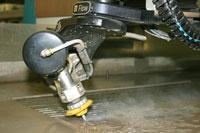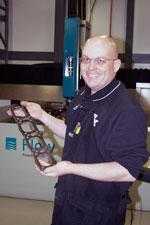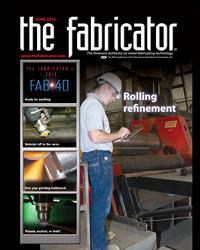Editor-in-Chief
- FMA
- The Fabricator
- FABTECH
- Canadian Metalworking
Categories
- Additive Manufacturing
- Aluminum Welding
- Arc Welding
- Assembly and Joining
- Automation and Robotics
- Bending and Forming
- Consumables
- Cutting and Weld Prep
- Electric Vehicles
- En Español
- Finishing
- Hydroforming
- Laser Cutting
- Laser Welding
- Machining
- Manufacturing Software
- Materials Handling
- Metals/Materials
- Oxyfuel Cutting
- Plasma Cutting
- Power Tools
- Punching and Other Holemaking
- Roll Forming
- Safety
- Sawing
- Shearing
- Shop Management
- Testing and Measuring
- Tube and Pipe Fabrication
- Tube and Pipe Production
- Waterjet Cutting
Industry Directory
Webcasts
Podcasts
FAB 40
Advertise
Subscribe
Account Login
Search
Race team embraces waterjet cutting
John Force Racing found a fabricating tool to improve the shop's turnaround times
- By Dan Davis
- June 3, 2013
- Article
- Waterjet Cutting

Figure 1: The production of the approximately 750 tabs and brackets used in the manufacture of John Force Racing Funny Cars is done primarily with a Flow waterjet. The machine helps the team to reduce the time it takes to build a complete chassis, which is more than 300 labor-hours.
When fans watch John Force, winner of 134 National Hot Rod Association (NHRA) races and a legend in straight-line racing, sit behind the wheel of his Castrol GTX Ford Mustang Funny Car, they are looking for four seconds of thrills—a supercharged car screaming down a 1,000-foot track at more than 300 miles per hour. They aren’t thinking about how the race team fabricated a gasket or bracket for the car prior to the race. It’s not a made-for-TV moment like two Funny Cars barreling down the track in search of a very simple goal of finishing first.
But to dismiss the work of the support staff for an NHRA team would be wrong. In a sport where even crew chiefs are measured by wins, much like the drivers behind the steering wheels of these powerful vehicles, the contributions of the mechanics, machinists, and fabricators at the track and at the shop can’t be understated.
Force realizes this, and it’s one of the reasons that he has invested so heavily in his racing shop in Brownsburg, Ind. He began moving manufacturing to Indiana from his longtime headquarters in Yorba Linda, Calif., almost 10 years ago, and now the race team occupies close to 150,000 sq. ft., where it has dedicated machining, fabricating, and painting and decal areas.
John Force Racing Inc. (JFR) needs all of that space as it maintains four racing teams—Force's Castrol GTX Ford Mustang Funny Car, Robert Hight's Auto Club of Southern California Ford Mustang Funny Car, Courtney Force's Traxxas Ford Mustang Funny Car, and Brittany Force’s Castrol Edge top fuel dragster. Hight, who won the NHRA championship in 2009, is JFR president and is married to John Force’s daughter Adria, who acts as the company’s chief financial officer. Courtney, who won the circuit’s rookie of the year award in 2012, and Brittany, who drives JFR’s first-ever dragster, are daughters of John Force.
In the Indiana race shop’s main bay, all four race teams and their support trucks line up side-by-side-by-side-by-side, as if they were set up at a race track. Mechanics, with about 10 on each team, prepare the cars for upcoming races. Approximately 30 other employees work in the machine, fabricating, and paint shop, providing support to mechanic and research and development activities. The rest of the JFR family, about 50 employees, is involved in everything from parts management to partnerships and licensing. It’s no small affair.
“We are aggressive. Move at a fast pace. A lot of research and development. Put it into production, get it on the car, see the results on the track, and adjust from there,” said Jason Sharp, JFR’s general manager, as he raced through an interview. “It’s not laid back because we are a race team.”
Time is of the essence on—and off—the track. The NHRA season stretches from mid-February to mid-November. During that time, race teams can be away from the Indiana shop for as long as three weeks in a row. (Part of the allure of moving to Indiana for the JFR teams was that it is centrally located to most racing events and allows the teams to come home in between events located in the Midwest and the Midsouth.) Off-season testing for the JFR team is typically done for one week in December and one week in January at a track in Florida.
The team doesn’t have a lot of downtime, and when it’s racing season, it’s “go” time. Everyone is working toward squeezing a few more miles per hour out of the supercharged vehicles.
Fabricators can sympathize with those types of production demands. They’d also be surprised at how similar JFR’s production environment is to their very own.
Bringing It All In-House
JFR didn’t start out with a large-scale manufacturing operation. In fact, in the 1970s and early 1980s, John was just interested in surviving until the next race.

Figure 2: Complex parts can be cut quickly on the waterjet as well, thanks to the equipment’s Dynamic cutting head. An articulated wrist lets the cutting head tilt in any direction, while simultaneously compensating for stream lag and taper. Such a capability is useful for cutting out a countersink for a bolt on something like an engine plate.
As success started to come in the late 1980s and John expanded his racing operations, the team was able to begin focusing on R&D efforts and winning on a consistent basis. However, the racing community in California is very tight-knit, so when the JFR team outsourced a
part to be tweaked in an effort to increase performance on a Funny Car, it always ran the risk that the improved part would find its way onto competitors’ cars. In some instances, JFR ended up doing R&D for several teams, not just one.
So by 2008 the race team decided to pull a majority of its manufacturing activities in-house (see Figure 1). Just as fabricators know, JFR found it could control quality and delivery of the part better by doing its own manufacturing. It was also nice to eliminate any “unofficial” subsidies for competitors’ racing improvements.
Now JFR has more than 30 MAG Fadal machining centers, a TRUMPF TruPunch 1000 punching machine, and a new Flow Mach 4 waterjet with a HyperJet® pump rated at 94,000 PSI.
“About 80 percent of the stuff that is on the car we produce in-house. Engine blocks, cylinder heads, superchargers, supercharger rotors, and titanium flywheel assemblies are just a few of the items,” Sharp said. “We’ve got a parts room that is 15,000 sq. ft. and two people just steward that all day long.”
Living With Tight Turnarounds
This isn’t a lead-time of three to four weeks. Typically, when a JFR team needs a part, it needs it as soon as possible.
For example, Sharp said Hight was at a test session in West Palm Beach, Fla., in January, and he wanted to try a different geometry on the brake handle of his car. Testing in the race shop in Indiana just didn’t reveal the slight inconsistencies he noticed while actually racing, and he wanted to try a different design for testing. Hight sketched a new design and sent it to the engineer in Indiana around 4 p.m. on a Thursday afternoon. The engineer created a CAD drawing of the part and sent it to the waterjet operator, who proceeded to cut the part out.
“By 5:30 p.m. that part was finished, polished, and in a box next-day air to the race track. They were able to put it in the car Friday morning and actually get feedback,” Sharp said.
The shop simply didn’t have that luxury before installing the waterjet two years ago. It would have to place a block of metal into a machining center and wait until all of the metal had been chipped away to arrive at the desired geometry. It’s not exactly as fast as throwing a piece of sheet metal on the waterjet table and cutting a part out in a matter of minutes (see Figure 2).
Norm Boutot, fabricating lead at JFR, said this quick turnaround comes in handy particularly when the race teams are trying out a new Funny Car chassis, as is the case this year. Drivers get out on the track, and they literally feel something that needs to be addressed, which typically means a change in part design.

Figure 3: Jeff Connolly, a machinist by training, is now the race team’s full-time waterjet operator. He said he enjoys working with the equipment because parts, such as this header flange, can be created easily in the software and produced in a matter of minutes.
“Normally we have to draw up a part and turn it around on-the-fly,” Boutot said.
Sharp added that the waterjet is useful even for those parts that need the tolerances that only a machining center can deliver. For instance, the waterjet can remove material much more quickly than a machining center can, so it’s perfect for roughing out a blank before it’s sent to machining.
“That 80,000 PSI on the waterjet will remove that [excess material] in 80 percent less time than setting the blank up in a fixture and having the tooling do it in a vertical mill,” Sharp said.
Working With Many Materials
Fabricating shops rarely work with just carbon steel, and the same goes for JFR. They routinely work with aluminum, chrome-moly, magnesium, titanium, and even metals typically reserved for aerospace applications, such as 4130 steel. Anything that can provide strong support without adding a tremendous amount of mass is looked upon as a competitive advantage. The waterjet also has been used to cut Delrin® plastic and wood-type composite material that might be needed for race-related activities, such as shop maintenance or packaging before traveling to a race track.
The waterjet doesn’t rely on thermal energy for cutting purposes, but instead on abrasive that travels in the waterjet stream and helps to remove material during the cutting process. As a result, the material retains its original material properties because it hasn’t been exposed to a heat-affected zone common with technologies such as laser and plasma cutting.
The amount of cutting activity keeps the waterjet busy (see Figure 3), and JFR has a full-time operator dedicated to the table.
Not Totally Like a Fabricating Operation After All
Of course, some of the manufacturing operations may be the same as in a fab shop, but the business model is completely different. JFR isn’t obsessed with uptime and maximizing machine capacity. It just needs to be able to respond quickly to the demands that the driver, the track, and the elements throw at the race team.
And the shop is beyond clean. It’s spotless. It’s not unusual to see two people cleaning the floor in the machining area—one pushing an industrial floor cleaner and another manually removing marks from the floor.
Such cleanliness is important because the shop is more than just a place to repair and build race cars; it’s a showplace to entertain the fans and sponsors, the lifeblood of the sport.
In a way, NHRA racing is a 24/7, 365-day endeavor. Mechanical repair, manufacturing, marketing, and sponsor meetings fill the calendar when the cars aren’t racing.
Sharp laughingly told John Force recently during a race, “The four seconds you are in that car is the easiest part of this whole deal.”
Force replied, “Yeah, but it’s still the most fun.”
What else would you expect from a Funny Car driver?
About the Author

Dan Davis
2135 Point Blvd.
Elgin, IL 60123
815-227-8281
Dan Davis is editor-in-chief of The Fabricator, the industry's most widely circulated metal fabricating magazine, and its sister publications, The Tube & Pipe Journal and The Welder. He has been with the publications since April 2002.
Related Companies
subscribe now

The Fabricator is North America's leading magazine for the metal forming and fabricating industry. The magazine delivers the news, technical articles, and case histories that enable fabricators to do their jobs more efficiently. The Fabricator has served the industry since 1970.
start your free subscription- Stay connected from anywhere

Easily access valuable industry resources now with full access to the digital edition of The Fabricator.

Easily access valuable industry resources now with full access to the digital edition of The Welder.

Easily access valuable industry resources now with full access to the digital edition of The Tube and Pipe Journal.
- Podcasting
- Podcast:
- The Fabricator Podcast
- Published:
- 04/16/2024
- Running Time:
- 63:29
In this episode of The Fabricator Podcast, Caleb Chamberlain, co-founder and CEO of OSH Cut, discusses his company’s...
- Trending Articles
AI, machine learning, and the future of metal fabrication

Employee ownership: The best way to ensure engagement

Steel industry reacts to Nucor’s new weekly published HRC price

Dynamic Metal blossoms with each passing year

Metal fabrication management: A guide for new supervisors

- Industry Events
16th Annual Safety Conference
- April 30 - May 1, 2024
- Elgin,
Pipe and Tube Conference
- May 21 - 22, 2024
- Omaha, NE
World-Class Roll Forming Workshop
- June 5 - 6, 2024
- Louisville, KY
Advanced Laser Application Workshop
- June 25 - 27, 2024
- Novi, MI


























